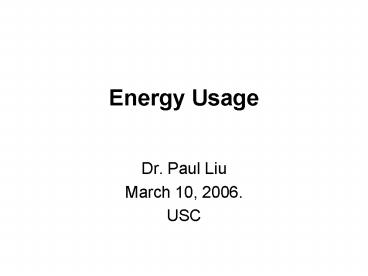Energy Usage - PowerPoint PPT Presentation
1 / 29
Title:
Energy Usage
Description:
Not as popular as gasoline, or diesel fuel. Gasoline. Complex mixture (b.p.850 to 4400F) ... 10% more diesel consumed. Contaminated Water Treatment needed. R & D Trend ... – PowerPoint PPT presentation
Number of Views:63
Avg rating:3.0/5.0
Title: Energy Usage
1
Energy Usage
- Dr. Paul Liu
- March 10, 2006.
- USC
2
Energy Usage
- Topics to be discussed include renewable
energy, and fossil fuels both in its natural and
converted forms with an emphasis on
bio-environmental impact.
3
Renewable Energy Resources
- Biomass
- Natural Form
- Distillation (Methanol)
- Fermentation (Ethanol)
- Solar Energy
- Wind Energy
- etc.
4
Fossil Fuel
5
Coal Gasification
Steam, O2
- coal pulverized ? gasifier? fluidized bed
Catalyst KOH
CO, H2 other
Catalyst nickel
CH4 emissions
6
- Pulverized Coal
- Submicron Lung Diseases
- Silicon Carcinogen
- 2. In Process
- Phenol (Benzophenol) C6H5OH
- Hydrogen Cyanide (HCN) highly toxic
7
Coal Liquefaction
Mixed w/air
Naptha Solvent
Reactor 800oF 1500 psia
Desulfurization
?
- coal pulverized ?
(Slurry)
Catalytic reactor
Condenser products (heavy oil, fuel gas,
naphtha, gasoline)
8
- 1. Slurry Mixing
- Naphtha Emission
- 2. Reactor Process
- Aromatic Liquid
- Naphtha Emission
Carcinogen
9
(No Transcript)
10
LPG
- Residential, Commercial, Urban Transit.
- Stored in pressurized cylinders.
- Limited capacity due to techn. restrictions.
- Pressurized cylinders are very expensive.
- Not cost effective.
11
(No Transcript)
12
CNG
- Limited uses in
- transit buses, fleet trucks, heavy duty engines
- Less refueling station available.
- Refueling time too long.
- Not as popular as gasoline, or diesel fuel.
13
Gasoline
- Complex mixture (b.p.850 to 4400F)
- HC-compounds
- aromatic (benzene ring, C6H6)
- olefin (double-bond carbon, propylene CH2CH-CH3)
- paraffin (straight-chain, petroleum gas, butane
C4H10, CH3-CH2-CH2-CH3) - Isoparaffin (branched chain,
CH3
Isoheptane
CH3-C-CH2-CH2-CH3
CH3
14
- Gasoline Powered Engine Emission
- CO toxic
- NOx interfere lung function
- SOx irritable odor, lung disease
- HC eye irritation, w/ NOx generate O3, lung
disease - PM micron mists of H2SO4, HNO3, respiratory
system disease
15
- Trace Elements
- benzo(a) pyrene (C20H12) active carcinogen
- phenanthrene (C14H10) suspected carcinogen
- pyrene (C16H10) suspected carcinogen
- anthracene (C6H4(CH)2C6H4) suspected carcinogen
16
Possible causes
- Incomplete combustion
- Too much toxic compounds in gasoline
- 3 Approaches
- Gasoline blended w/ methanol (CH3OH)
- Gasoline blended w/ ethanol (C2H5OH)
- Reformulated Gasoline
17
Gasoline-Methanol Blend
- Distillation of Wood
- Gasoline-Methanol (10)
- Double Gasoline Vaporization rate
- Lower Combustion Temperature
- Less NOx, CO, unburn HC Emissions.
18
- Drawback
- 50 more fuel needed.
- Very Corrosive.
- Loose existing rust deposit.
- Vapor Lock in Fuel System.
- Water-Fuel Separation.
- Methanol Leak to form Formaldehyde
- CH3OH? CH2O (Carcinogen)
- Formaldehyde
Hydrogen ion H Formate COO-2 (Visual Organs)
Formic acid (CH2O2)
(oxidize)
(dissolved)
(CH2O)
19
Gasoline-Ethanol Blend (C2H5OH)
- Fermentation of Starchy crops
- (2/3 of) crops
Glucose C6H12O6
Ethanol C2H5OH
(anaerobic treated)
(yeast fermented)
1/3 of biomass
Xylose C5H10O5
(33 Waste)
Purdue Yeast To ferment xylose Increase 30-40
ethanol product.
20
Gasoline-Ethanol (10)
- Fuel Vaporization rate 50 increased
- Increase Octane Number
- Reduce Emissions
- Less sensitive to corrosion.
- Drawback
- 20 more fuel needed.
- Vapor Lock, Fuel Syst. Plug, Phase separation
- Relatively Expensive
21
Reformulated Gasoline
- Purpose Improve Air Pollution
- Reducing aromatic HC compounds
- Reducing sulfuric compounds
- Adding alkylate (isooctane C8H18)
- Adding oxygenate (MTBE Methyl Tertiary Butyl
Ether (CH3)3COCH3)
22
- Advantage
- adding MTBE improve combustion
- Adding isooctane C8H18 - improve octane
- Emit less pollutants (VOC, NOx, CO, SOx, O3)
- Reducing aromatic HC emit less toxic
- Reduce cancer risk
- Drawback
- Addition of MTBE add some cost
- More fuel consumed for same distance
- MTBE suspected carcinogen
- Low viscosity MTBE leak to water walls
23
Diesel Fuel
- From Distillation of Crude Oil
- Classified as NO. 2 fuel oil
- Straight run product from distillation
- Light-cracked from Catalytic Cracking Unit
- Catalyst AlCl3, aluminum chloride in crystal
form.
24
- Advantage
- Powerful and durable
- Excellent performance
- As fuel for trucks, ships, heavy duty machine
- Drawback
- Exhaust Emissions include CO, NOx, SOx, HC and
smoke - HC-benzo(a) pyrene (C20H12) active carcinogen
- Smoke carbon soot attached w/ HC, fine
particles. - Fine particles size in nano scale, pass through
lung passage, cancer risk gt 10 X benzene - Fine particles spread in crowd residential
commercial area.
25
CRT for Fine Particles
- CRT (Continuously Regenerating Trap)
- German Vehicle Co. of Johnson Matthey, Int. R
D. - Ceramic Catalyst Ceramic Filter
(collect carbon soot C)
(Platinum, precious metal)
- Oxidize
- NO ? NO2
- CO ? CO2
- HC ? CO2 H2O
heat
C ? CO ? CO2
Regenerate Filter
26
- Advantage
- 90 of Fine Particle in nano-range controlled.
- Very cost effective.
- Drawback
- NO2 emissions increased.
- Sensitive to sulfur content of fuel (poisoning
catalyst).
27
Aquazole Diesel for Fine Particles
- Aquazole Diesel
- Developed by French firm Elf Aquitaine.
- Water-Diesel mixture (ratio 17)
- Droplet size in micro- and nano-scale.
28
- Advantage w/ nano scale droplets
- 4/5 of fine particles controlled.
- 1/3 of NOx controlled.
- No filter needed.
- Drawback
- 10 more diesel consumed.
- Contaminated Water Treatment needed.
29
R D Trend
- Advanced Catalyst (Fuel Conversion)
- Super Conversion Yeast (Bio-fuel production)
- Efficient Photovoltaic Material (Solar-Electric
conversion) - Thermoelectric Active Material (Waste
Heat-Electric conversion) - Photochem. Active Material (Degrade nano-scale
toxic chemicals) - NOTE Study on bio-env. impacts,
- Public Well-being Promotion
- Public Health Protection































